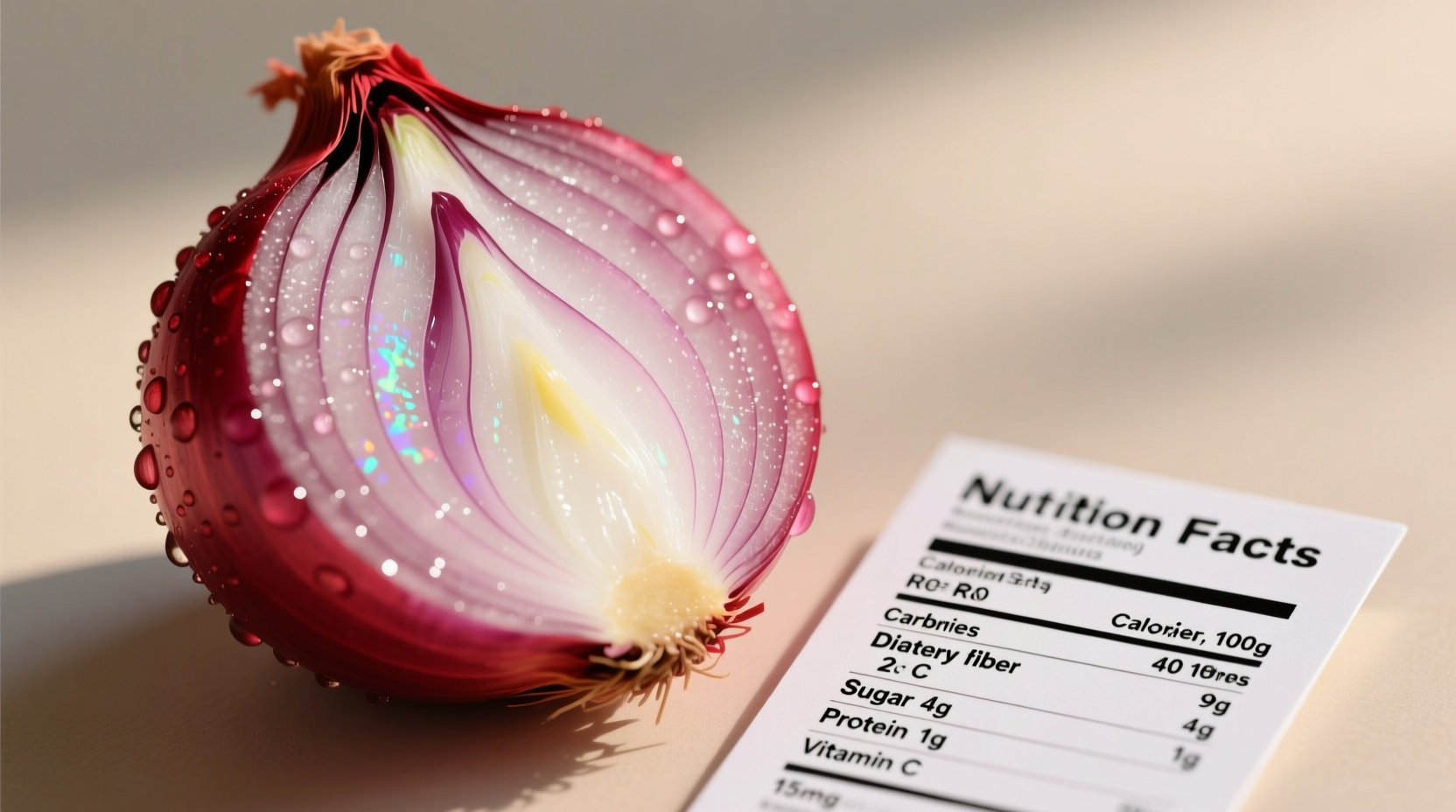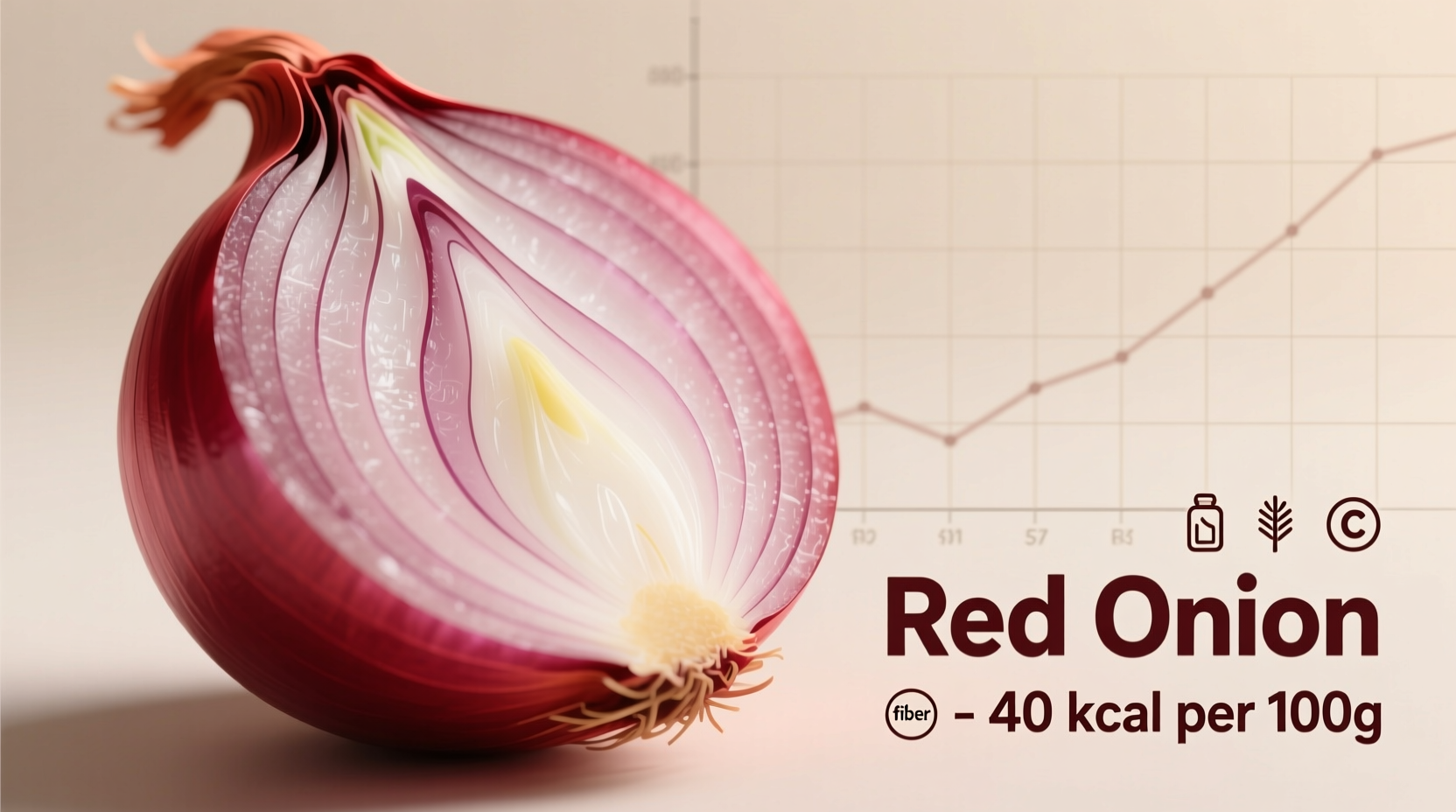Understanding the exact nutritional profile of red onions is crucial for health-conscious cooks and meal planners. Unlike many vegetables that vary significantly in calorie content based on preparation methods, red onions maintain their low-calorie advantage whether raw or lightly cooked. The USDA FoodData Central database confirms that 100 grams of raw red onion delivers just 40 kilocalories, making them an excellent choice for flavor without excess energy intake.
Red Onion Nutrition: The Complete Breakdown
When tracking your daily calorie intake, knowing precise nutritional values helps make informed choices. Red onions provide more than just flavor—they deliver valuable nutrients with minimal caloric cost. A medium-sized red onion (about 110g) contains approximately 44 calories, while a standard 1/2 cup chopped serving (80g) offers just 32 calories.
| Nutrient | Per 100g | % Daily Value* |
|---|---|---|
| Calories | 40 kcal | 2% |
| Carbohydrates | 9.3g | 3% |
| Dietary Fiber | 1.7g | 6% |
| Sugar | 4.2g | - |
| Protein | 1.1g | 2% |
| Vitamin C | 7.4mg | 8% |
| Potassium | 146mg | 3% |
*Percent Daily Values based on a 2,000 calorie diet. Source: USDA FoodData Central, Release 16

How Red Onions Compare to Other Varieties
Many home cooks wonder whether different onion types significantly impact their calorie counting. The nutritional differences between red, yellow, and white onions are minimal but worth noting for precision tracking:
- Red onions: 40 kcal per 100g, slightly higher in antioxidants
- Yellow onions: 42 kcal per 100g, more pungent flavor
- White onions: 43 kcal per 100g, milder taste profile
The slight variations come from differences in water content and natural sugar concentrations. All onion varieties remain excellent low-calorie options for enhancing dishes without significantly impacting your daily energy intake.
Practical Calorie Management with Red Onions
Red onions shine in calorie-conscious cooking because they add substantial flavor with minimal caloric cost. Consider these practical applications:
- Add 2-3 tablespoons of finely diced red onion to salads for just 4-6 calories
- Use as a base for soups and stews—1/4 cup provides flavor for under 10 calories
- Create vibrant salsas where red onion contributes texture and taste without excess energy
- Substitute for higher-calorie flavor enhancers like croutons or bacon bits
When monitoring red onion kcal for weight management, remember that cooking methods affect final calorie density. Raw red onions maintain their 40 kcal per 100g profile, while caramelizing concentrates flavors and slightly increases calories per volume as water evaporates.
Understanding Nutritional Variability Factors
Several factors can cause minor variations in red onion nutritional content:
- Seasonal differences: Onions harvested in late summer may contain slightly more natural sugars
- Storage conditions: Properly stored onions maintain nutritional value for 2-3 months
- Preparation methods: Soaking can reduce sulfur compounds but doesn't significantly alter calorie count
- Geographic origin: Soil composition affects mineral content but not caloric value
The National Onion Association notes that red onion cultivation has evolved significantly since ancient Egyptian times, when they were considered sacred and used as currency. Modern agricultural practices have stabilized nutritional profiles, making today's red onions remarkably consistent in their calorie content across different markets.
Health Benefits Beyond Calories
While tracking red onion kcal matters for energy balance, these vibrant vegetables offer additional health advantages:
- Rich in quercetin, a powerful antioxidant with anti-inflammatory properties
- Contain anthocyanins that give red onions their distinctive color and health benefits
- Support cardiovascular health through sulfur compounds
- Promote digestive health with prebiotic fiber content
Research published in the Journal of Agricultural and Food Chemistry confirms that red onions maintain higher antioxidant levels compared to other varieties, making them particularly valuable for health-focused diets despite their nearly identical calorie profile.
Smart Incorporation into Daily Meals
Maximize the nutritional benefits of red onions while staying within your calorie goals with these practical strategies:
- Add raw red onion slices to sandwiches instead of higher-calorie condiments
- Create colorful vegetable stir-fries where red onion enhances flavor without added fats
- Use as a garnish for baked potatoes to replace higher-calorie toppings
- Include in egg dishes for added flavor and nutrients with minimal calorie impact
For those following specific dietary patterns, red onions fit well within Mediterranean, DASH, and plant-based eating approaches. Their low glycemic index (approximately 10) makes them suitable for blood sugar management diets when consumed in reasonable portions.











 浙公网安备
33010002000092号
浙公网安备
33010002000092号 浙B2-20120091-4
浙B2-20120091-4